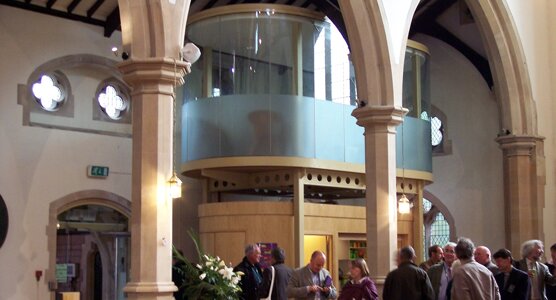New design work in historic places of worship

English Heritage wishes to secure the future of this country’s historic places of worship as living buildings at the heart of their communities. We believe that they should be well used, and visited and enjoyed by all. To this end, we will work with congregations to accommodate changing patterns of use while seeking to protect the special architectural and historical interest of the buildings.
New Work in Historic Places Of Worship sets out the principles that English Heritage applies when considering proposals for the alteration or extension of historic places of worship. It is aimed at all those responsible for formulating proposals and making decisions about such buildings. For the sake of simplicity, the word ‘church’ has generally been used to mean a place of worship of any denomination or faith, and ‘congregation’ to mean the users of that place of worship. This document was published in September 2003.
Introduction
England possesses a richly varied inheritance of historic churches and chapels. The term ‘historic church’ may conjure up the image of a medieval village church, and indeed a high proportion of historic churches is of this type. However, this heritage also includes Georgian, Victorian and 20th-century buildings, both urban and rural, and encompasses every denomination and faith.
Most historic churches remain in use for worship and English Heritage will support the efforts of congregations to keep them in use wherever possible. This is their purpose, and as a rule historic buildings are best used for their intended purpose.
Alternative uses are not always easy to find and can be damaging to the special architectural or historic interest of the building.
Historic church buildings are the heritage of all, and interest in their care and development extends well beyond the worshipping communities. They are frequently the finest buildings in their surroundings, central to the settlements they serve and of major townscape or landscape importance. They are repositories of the best that previous generations could offer in terms of design, craftsmanship and skill. They tell us how previous generations lived, thought and worshipped. They are integral to our sense of place and belonging.
Patterns of change
Most churches have been altered or rearranged several times over the centuries to meet changing needs, and the evidence of change is often an essential part of our appreciation of such buildings. Medieval parish churches were regularly enlarged or beautified to accommodate the liturgies of the living and the wishes of the dead.
In the post-medieval period they were radically altered to suit the requirements of the reformed liturgy. Nor, of course, did the building of new places of worship cease. From the end of the 17th century religious dissent was increasingly allowed architectural expression and many fine Nonconformist chapels are the result. During this period new places of worship also began to be built by incoming religious and ethnic groups who were often escaping persecution in other countries. The 18th-century Methodist and 19th century Catholic revivals produced distinctive buildings, from small chapels to larger churches, and many existing Anglican churches were altered and enlarged (for example, in the provision of galleries to increase seating capacity).
In the 19th century all denominations built prolifically, including new ancillary buildings for Sunday schools and social purposes. Post-medieval changes to old parish churches were often swept away in an attempt to ‘restore’ buildings to an idea of their correct medieval form. Through the 20th century up to the present, places of worship for all denominations and faiths have continued to be built and adapted, reflecting a wide range of architectural styles and cultural influences.
In recent times liturgical, social and economic changes have often led to a radical reappraisal of the way that historic places of worship may be used. Thus community participation rather than hierarchy has been emphasised, and the architectural settings associated with previous modes of worship often seen as inappropriate.
Coupled with these changes has been an increased emphasis on comfort and convenience. It is now widely expected that public places of worship should have comfortable heating and seating, a lavatory, a modest kitchen and a space for meetings. There is also an increasing emphasis on broadening the use of church buildings, especially the main congregational space, beyond that of regular worship.
While places of worship have changed over time, this has not been an entirely neutral process. Some changes have been for the better and some have not. Inevitably there is sometimes a tension between the desire for change and the aims of conservation. It is the purpose of this document to reduce the scope for conflict and to ensure that a proper balance is reached between the needs of the users of the building and the desirability of conservation.
What's New?
-
The National Heritage List for England is now live on the English Heritage website.
-
Welcome to the HER21 page. This page offers access to the full suite of HER21 project reports.
